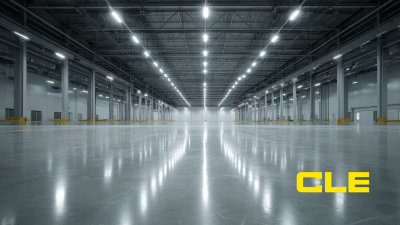How to Choose the Right Light Source for Your Home and Business Needs
The choice of the right light source is vital for enhancing functionality and aesthetics in both home and business environments. As lighting accounts for approximately 15% of the total energy consumption in commercial spaces, selecting energy-efficient solutions not only contributes to lower utility costs but also improves sustainability (U.S. Department of Energy, 2020).

With the lighting industry projected to reach a value of $150 billion by 2024, driven by advancements in LED technology and smart lighting solutions, the importance of making informed choices is more pertinent than ever (MarketsandMarkets, 2021). By understanding the distinct characteristics of various light sources, including their color temperature, energy efficiency, and application suitability, individuals can create spaces that are both inviting and efficient. This guide will explore critical considerations and best practices for selecting the ideal light source tailored to specific needs.
Understanding Different Types of Light Sources: A Comprehensive Overview
When selecting the appropriate light source for your home or business, it's essential to understand the various types available. Firstly, incandescent bulbs, which have been a popular choice for their warm glow, provide a cozy ambiance. However, they are less energy-efficient compared to newer technologies.

Fluorescent lights, commonly used in commercial settings, are more energy-efficient and have a longer lifespan, making them ideal for environments requiring consistent illumination.
LEDs (Light Emitting Diodes) are rapidly gaining popularity due to their versatility and efficiency. They offer a range of color temperatures, making them suitable for both task lighting and aesthetic purposes. Additionally, their longevity and reduced energy consumption make them environmentally friendly. Lastly, halogen bulbs, a variant of incandescent bulbs, offer brighter light and enhanced color rendering but do so at the cost of energy efficiency. Understanding these differences allows you to make an informed choice that best suits your lighting needs while considering factors like energy consumption, bulb lifespan, and overall atmosphere.
Evaluating Your Lighting Needs: Home vs. Business Requirements
When evaluating lighting needs, it’s essential to consider the distinct requirements of home versus business environments. In residential settings, lighting should prioritize comfort, ambiance, and energy efficiency. For instance, adjustable desk lamps can create a conducive workspace, ensuring adequate illumination for tasks without causing eye strain. Home lighting should also account for the potential impact of light pollution, especially in urban areas where external lights are increasingly used to enhance nighttime activities.
In contrast, business lighting must focus on functionality and productivity. Efficient lighting solutions can improve the overall work environment and employee performance. Evaluating resource use in the lighting sector, as highlighted by recent studies, is crucial for both homes and businesses. For businesses, adopting sustainable practices not only contributes to reduced operational costs but also aligns with growing environmental regulations, such as those stemming from extended producer responsibility (EPR) initiatives. Thus, a thorough assessment of lighting needs tailored to specific environments can lead to better decision-making and enhanced satisfaction both at home and in business settings.
Energy Efficiency and Cost: Selecting Sustainable Lighting Solutions
When selecting the right light source for your home and business, energy efficiency and cost are paramount considerations. According to the U.S. Department of Energy, lighting accounts for about 15% of an average home's electricity use. By opting for energy-efficient lighting solutions, such as LED bulbs, homeowners can reduce energy consumption by up to 75% compared to traditional incandescent bulbs. This shift not only lowers electricity bills but also contributes to a reduction in greenhouse gas emissions, promoting a more sustainable environment.
**Tips:** When choosing light sources, consider bulbs with a high luminous efficacy, which measures how much light a bulb produces per watt of electricity used. Look for products that have the ENERGY STAR label, as these are verified to meet energy efficiency guidelines. Additionally, consider the upfront cost versus the long-term savings—while LED bulbs may be more expensive initially, their extended lifespan and energy savings make them a cost-effective choice.
In commercial settings, the benefits of adopting sustainable lighting solutions can be even more significant. A study from the American Council for an Energy-Efficient Economy indicates that businesses can save about $1,000 for every kilowatt saved through energy-efficient lighting upgrades. Moreover, implementing smart lighting controls can lead to additional savings of up to 20%, allowing for better management of energy use throughout the day.
How to Choose the Right Light Source for Your Home and Business Needs - Energy Efficiency and Cost: Selecting Sustainable Lighting Solutions
| Light Source Type | Energy Efficiency (Lumens/Watt) | Average Lifespan (Hours) | Initial Cost ($) | Annual Energy Cost ($) | Environmental Impact |
|---|---|---|---|---|---|
| LED | 80-100 | 15,000 - 50,000 | 10 - 20 | 10 - 15 | Low |
| CFL | 60-70 | 7,000 - 15,000 | 4 - 10 | 15 - 25 | Moderate |
| Incandescent | 10-17 | 1,000 - 2,000 | 1 - 2 | 25 - 40 | High |
| Halogen | 15-25 | 2,000 - 4,000 | 3 - 6 | 20 - 35 | High |
| Fluorescent | 35-100 | 7,000 - 15,000 | 5 - 20 | 15 - 30 | Moderate |
Aesthetic Considerations: How to Match Lighting with Your Interior Design
When considering how to match lighting with your interior design, aesthetics play a pivotal role. The interplay between light and design contributes significantly to the overall ambiance of a space. According to recent studies, well-designed lighting can enhance the perception of a room’s dimensions by up to 10%, creating a more inviting atmosphere. For instance, integrating soft, warm light in living spaces encourages relaxation and sociability, while cooler tones can be used in work environments to boost focus and productivity.
AI technologies are increasingly being employed to optimize lighting solutions based on aesthetic principles. These advancements allow homeowners to visualize their interiors in real-time, assessing how different lighting choices can complement various design elements—from color palettes to furniture styles. Reports indicate that AI-driven tools can analyze a room’s layout and suggest lighting configurations that not only enhance aesthetic appeal but also improve energy efficiency by up to 30%. Thus, selecting the right light source involves a careful consideration of both aesthetic needs and technological solutions to achieve a balanced and harmonious interior.
Smart Lighting Technologies: Enhancing Functionality and Comfort in Spaces
When selecting the right light source for your home or business, it's essential to consider the latest advancements in smart lighting technologies. These innovations not only enhance the functionality of spaces but also significantly improve comfort levels. According to a recent market report, the global smart lighting market is projected to witness a compound annual growth rate of 7.1%, underscoring the burgeoning interest in integrated lighting solutions that enhance user experience and energy efficiency.

Tips for choosing smart lighting include evaluating the compatibility of systems with existing home automation setups and considering adjustable lighting options to suit various activities. For instance, using smart bulbs that can alter brightness and color temperature based on the time of day can create an inviting atmosphere, whether for work or relaxation. Remember, integrating artificial intelligence into your lighting can optimize energy consumption and reduce utility costs, making it an investment worth considering.
With the rise of AI-powered homes, it's clear that smart lighting is becoming a fundamental aspect of modern residential design. Look for products that allow for remote control and scheduling through apps, as these features significantly enhance convenience. Additionally, pay attention to innovations in lighting that promote well-being, such as circadian lighting that mimics natural light patterns, contributing to improved mood and productivity.
Related Posts
-

Enhancing Manufacturing Efficiency with Light Source Technology in Industrial Applications
-

Advantages of Embracing Industrial Lighting for Your Business
-

The Definitive Handbook for Sourcing Innovative Home Lighting Solutions Worldwide
-

Exploring Global Opportunities: The Surge of Foreign Buyers at the 137th Canton Fair for Design Lighting Innovation
-

China's Resilient Growth in Best General Lighting Amidst US China Tariff Challenges
-

Unmatched Quality of Best Commercial Warehouse Lighting Made in China for Global Buyers
